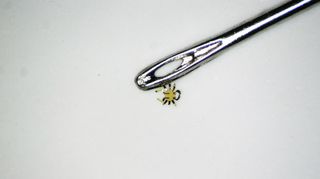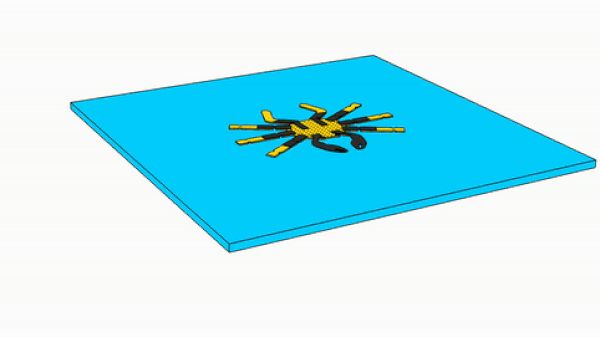This sideways-scooting robot crab is so tiny it fits through the eye of a needle
The tiny critter is controlled using lasers.

Engineers have developed the world's tiniest remote-controlled walking robot, and it mimics a mini crab that can shuffle sideways without any wires, hydraulics, electricity or other standard mechanical components.
The robotic crabs — which span just one-fiftieth of an inch wide (0.5 milimeters) wide — can also bend, twist, turn around and even jump. Normally, walking robots have a mechanical design with lots of moving parts powered by a source of electricity. However, these eight-legged critters have a much more simplified design consisting of only a few nifty materials that can be manipulated by lasers.
The crustacean-like robots are made from an elastic "memory-foam" alloy that gets transformed into its 3D shape like a children's pop-up book: A 2D crab-shaped alloy outline is attached to a stretched-out rubber substrate at the robot's feet; when the substrate is relaxed and decreases in surface area the material is forced upward into the desired 3D crab shape.

When the 3D alloy is heated by a laser, it tries to revert to its original flattened-out 2D shape. However, before the alloy can fully flatten out, it quickly cools down and springs back into the 3D crab shape. This rapid changing of shape is what gives the robot movement.
A special glass coating on the alloy makes it easier to direct lasers to heat up certain areas of the robot, which allows for a wide range of movements. To make the crab walk sideways, the laser is shone from one side of the body to the other creating a sort of wave through the body as it flattens and springs back into shape; that wave of motion causes the itty-bitty crab to move in the direction of the laser.

Related: Pac-Man-shaped blobs become world's first self-replicating biological robots
The new robot can move at a max speed of around half its own body length per second, according to the statement. This impressive speed is only possible because of how fast the robot's materials cool after being heated up by the laser. "Because these structures are so tiny, the rate of cooling is very fast," senior researcher John Rogers, a biomedical engineer and nanotechnology expert at Northwestern University in Illinois, said in a statement. "In fact, reducing the sizes of these robots allows them to run faster."
Sign up for the Live Science daily newsletter now
Get the world’s most fascinating discoveries delivered straight to your inbox.




While watching the robot move, you might think that its locomotion was inspired by its crab shape. However, it was actually the other way around; students at Northwestern University nailed down that shape after learning how the material responded to lasers. "It was a creative whim," Rogers said. "The students felt inspired and amused by the [similarities with] sideways crawling motions of tiny crabs."
The researchers also created millimeter-size robots resembling inchworms, crickets and beetles in the new study. "With these assembly techniques and materials concepts, we can build walking robots with almost any size or 3D shape," Rogers said.
In 2021, the same research group also created the world's smallest flying microchip, which was the same size as a grain of sand and mimicked the shape of maple tree seeds, they reported at the time.
Besides looking adorable, these little machines could also do valuable work. "You might imagine micro-robots as agents to repair or assemble small structures," Rogers said, "or as surgical assistants to clear clogged arteries, to stop internal bleeding or to eliminate cancerous tumors — all in minimally invasive procedures."
The study was published online May 25 in the journal Science Robots.
Originally published on Live Science.

Harry is a U.K.-based senior staff writer at Live Science. He studied marine biology at the University of Exeter before training to become a journalist. He covers a wide range of topics including space exploration, planetary science, space weather, climate change, animal behavior, evolution and paleontology. His feature on the upcoming solar maximum was shortlisted in the "top scoop" category at the National Council for the Training of Journalists (NCTJ) Awards for Excellence in 2023.
Most Popular



